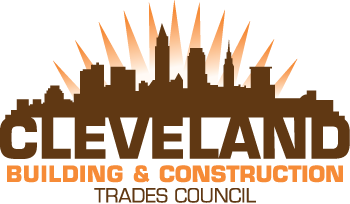Area Trades Finish Progressive Field Improvements
Photo [Above, Left] - A group of tradeswomen pose for a group picture while working on Phase II renovations at Progressive Field. The project provided jobs for 76 tradeswomen.
Photo[Above, Right] - An artist rendering of the Lexus Carnegie Club. Affiliated members of the Cleveland Building Trades completed the work on Phase II renovations at Progressive Field in May. Overall, the ballclub spent over $200 million upgrading the 31-year-old ballpark during the 2023 and 2024 offseasons.
Cleveland’s Major League Baseball stadium on the corner of Carnegie and Ontario has a fresh look and new amenities for fans.
Affiliated members of the Cleveland Building and Construction Trades Council recently completed Phase II renovations of Progressive Field.
Despite starting several weeks later than initially planned due to Cleveland’s extended postseason run, the Phase II work – performed under a Community Benefits Agreement – was completed on time.
The ninth oldest Major League Baseball stadium, the building many fans still affectionately call “The Jake,” turned 31 years old this season. However, the renovation work puts the ballpark on par with many of its newest contemporaries.
The improvements include turning the area that used to be the Terrace Club into the Terrace District, building the Lexus Carnegie Club and swapping out the remaining green seats with blue seats.
Located down the left field line, the Terrace Garden rooftop patio opened last season. This offseason, crews added The Terrace Hall and Keybank North Coast Social to that area.
The Terrace Hall is a “reimagined” beer hall open to all fans with a sleek retro vibe that includes an exposed steel and wood baffle bar ceiling. The area includes indoor and outdoor spaces to watch games and a wide selection of local craft beers, according to the team’s official description.
The Keybank North Coast Social, located downstairs from The Terrace Hall, offers exclusive access to an upscale indoor lounge, as well as open-air box seating featuring heated seats.
The Lexus Carnegie Club, which opened during the second homestand, is a new, members-only club located behind home plate. It features an all-inclusive premium bar and menu, along with convenient grab-and-go beverages, allowing fans to enjoy a meal in an upscale indoor environment or easily get back to their seats to watch the game.
Clevelanders and those familiar with the area will notice that the new spaces were inspired by the West Side Market and the Guardians of Traffic, the team’s namesake.
“We’re really fortunate,” said Christy Corfias, Cleveland Guardians Vice President of Business Strategy and Analytics. “We've got really good public partners at the city, county and state who helped us invest in the ballpark. This is a significant investment, and we're making investments all the time to keep it up to date.
“I think we've got a bright future ahead of us as the crown jewel of Cleveland,” she added.
“The updates were needed and welcomed,” said Cleveland Building and Construction Trades Council Executive Secretary/Business Manager Dave Wondolowski
The Phase I renovations were also completed under a Community Benefits Agreement, with the work done before the start of the 2024 season. It included new social areas in the upper deck, a new administrative building on E. 9th Street and the installation of some new blue seats.
According to Wondolowski, both phases combined to create about 600 jobs for affiliated members. The combined price tag for both phases was over $200 million.
Not only did the project renovate the classic ballpark and bring it into the future, but it also helped promote diversity, equity and inclusion on the construction side.
According to data released by the team, the project met two of its CBA goals for construction workers, including 45 percent of the jobs going to Cuyahoga County residents and 3 percent to those considered low income. They just missed hitting the hiring goals for females and minorities.
The team confirmed that 76 tradeswomen from various trades worked on the project.
When it came to the contractor side, the project nearly doubled its target of female owned businesses, which represented about 15 percent participation. They also met the goal for Hispanic-owned business (3 percent) and nearly hit the mark for minority-owned business.
“I’ve always felt that the inclusion of the community, working together on a project in their own community, helps towards its ultimate success,” said Wondolowski.


